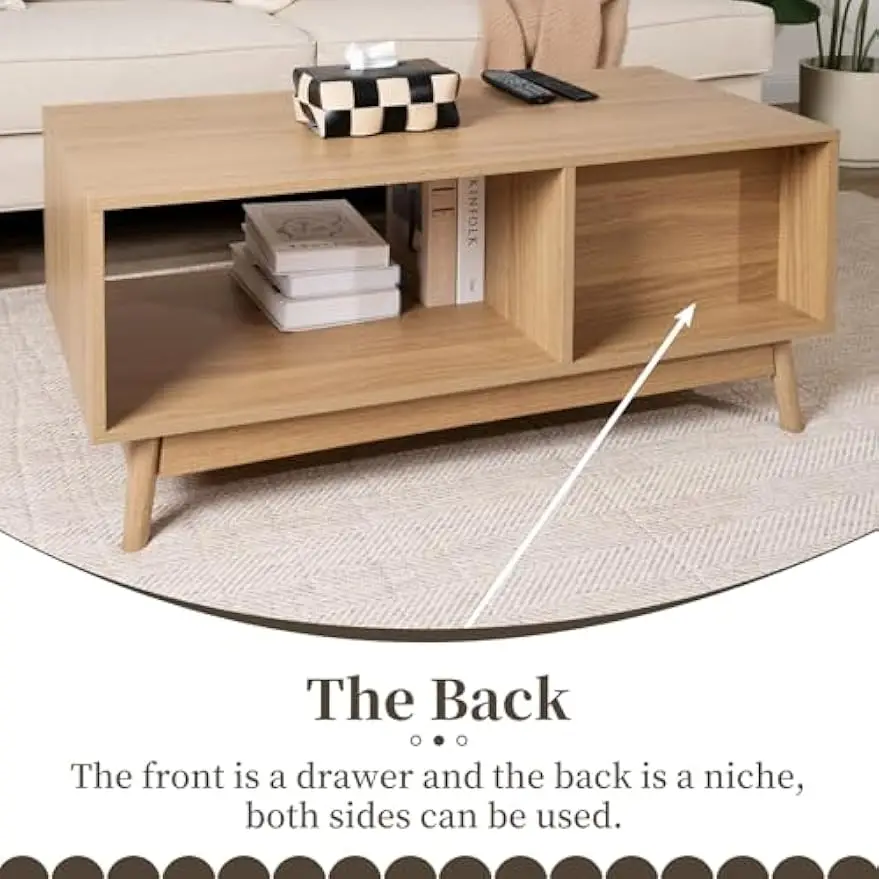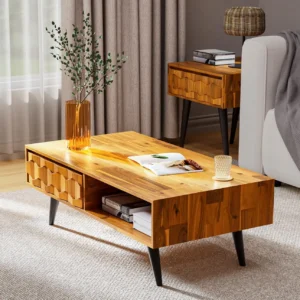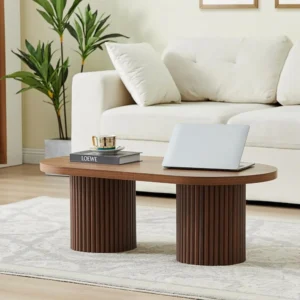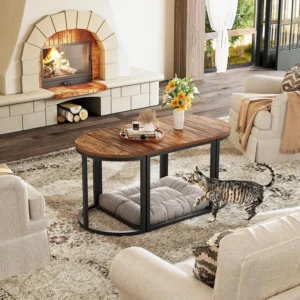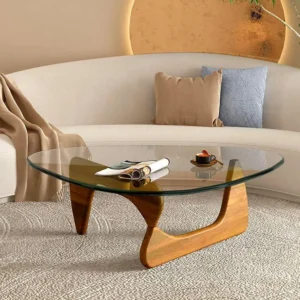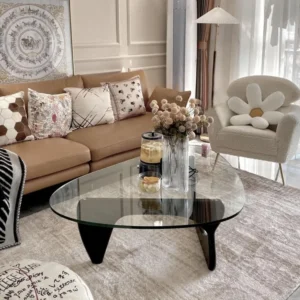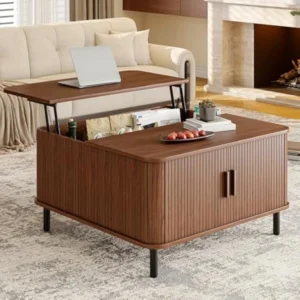The Enduring Allure of Danish Design: Your Perfect Coffee Table
In a world of ever-changing interior design trends, Danish-inspired furniture continues to maintain its remarkable popularity. This enduring appeal isn’t simply about aesthetics—it represents a deeper philosophy that resonates with how we want to live today. Danish coffee tables, in particular, embody this perfect marriage of form and function, offering clean lines and practical utility without unnecessary embellishment.
What makes a coffee table truly “Danish-inspired” goes far beyond appearance. It represents a design approach centered on craftsmanship, quality materials, and the belief that beautiful objects should also be supremely functional. These principles emerged strongly in the mid-20th century but feel completely relevant to modern living spaces today.
Nearly 70% of interior designers report that Scandinavian design elements remain among the most requested styles for living spaces—and for good reason. Whether your home leans minimalist, eclectic, or somewhere in between, Danish-inspired coffee table designs bring a timeless quality that adapts beautifully to changing surroundings.
Throughout this guide, you’ll discover how to identify authentic Danish design elements, recognize quality craftsmanship, and find the perfect coffee table for your space. Understanding the comprehensive guide to Danish coffee table design will help you make choices that not only enhance your interior but bring lasting satisfaction.
Core Principles of Danish Furniture Design
Danish design philosophy follows clear principles that have stood the test of time. Understanding these foundations will help you recognize authentic Danish-inspired pieces and appreciate their enduring appeal.
Simplicity and Minimalism
At the heart of Danish design lies an unwavering commitment to simplicity. This doesn’t mean stark or bare—rather, it reflects a thoughtful reduction to essential elements. Danish coffee tables often appear effortlessly elegant because they avoid unnecessary ornamentation, allowing the natural beauty of materials and proportions to shine through. This minimalist approach creates pieces that feel both timeless and contemporary.
Form Follows Function
Perhaps no principle defines Danish design more completely than its dedication to functionality. Every element serves a purpose, and practical considerations drive aesthetic decisions. Danish modern coffee table elements like slightly raised edges to prevent items from falling off, integrated storage solutions, or adjustable components all demonstrate this philosophy in action. This approach ensures these pieces work beautifully in everyday life.
Exceptional Craftsmanship
Danish furniture designers elevate craftsmanship to an art form. Precise joinery techniques—often visible as part of the design—create sturdy, long-lasting pieces without sacrificing visual lightness. This attention to detail extends to every aspect, from carefully smoothed edges to perfectly balanced proportions. The result is furniture that remains beautiful and functional for generations.
Material Honesty
Danish designers showcase rather than conceal the natural qualities of their materials. Wood grain patterns become design elements, and finishes enhance rather than mask the innate beauty of materials. This honesty creates an authentic connection between the furniture and its user, allowing the character of natural materials to develop a rich patina over time.
Organic Forms and Clean Lines
While adhering to clean lines and geometric clarity, Danish furniture often incorporates subtle organic curves that create visual interest and ergonomic comfort. These softened elements help Danish coffee tables feel both modern and invitingly warm, distinguishing them from more severe minimalist styles.
The Concept of Hygge
The Danish concept of “hygge” (pronounced “hoo-ga”)—a quality of coziness and comfortable conviviality—influences furniture design by emphasizing how pieces contribute to a warm, welcoming atmosphere. Coffee tables, as central gathering points in living spaces, particularly embody this principle through inviting proportions and tactile materials.
Understanding the difference between mid-century and mid-century modern furniture helps place Danish design in its broader context. While Danish Modern represents a specific regional expression within the broader Mid-Century Modern movement, it maintains distinctive characteristics that set it apart through its exceptional craftsmanship and material focus.
Essential Materials in Danish Coffee Table Design
The materials used in Danish coffee tables aren’t merely structural components—they’re central design elements that define the aesthetic and durability of each piece. Understanding these materials helps you appreciate their qualities and make informed choices.
Wood: The Primary Material
Wood forms the heart and soul of Danish coffee table design, with specific varieties chosen for their unique properties:
Teak
– Rich, warm golden-brown color that deepens beautifully with age
– Naturally high oil content provides inherent resistance to moisture and decay
– Exceptionally stable with minimal warping or cracking over time
– Often featured in teak coffee tables with Danish-inspired design elements
Oak
– Strong, durable wood with distinctive grain patterns
– Lighter color that creates an airy, contemporary feel
– Often treated with soap or oil to preserve its natural appearance
– Excellent structural properties for long-lasting furniture
Walnut
– Deep, chocolate-brown tones with purple undertones
– Straight grain often featuring dramatic figuring
– Creates a more sophisticated, formal appearance
– Frequently seen in walnut coffee tables featuring Danish design principles
Rosewood
– Rich reddish-brown color with dramatic dark veining
– Dense, heavy structure provides exceptional stability
– Often reserved for premium pieces due to limited availability
– Creates a striking visual centerpiece in any room
Traditional Finishing Techniques
Danish furniture makers typically employ finishing methods that enhance rather than mask the wood’s natural characteristics:
- Oil finishes penetrate the wood, creating a satin luster that deepens over time while allowing the grain texture to remain tactile
- Soap treatments for oak create a distinctive matte appearance that resists stains while maintaining breathability
- Hand-rubbed wax creates a protective layer while enhancing depth and luster
- Sparing use of lacquer when needed for additional protection without creating an artificial appearance
Complementary Materials
While wood dominates Danish coffee table design, other materials often provide functional or visual contrast:
- Glass tops create visual lightness while protecting wood surfaces
- Ceramic tile inserts, particularly in vintage pieces, add color and texture
- Brass or steel elements provide structural support with minimal visual weight
- Woven elements like paper cord or cane occasionally appear in storage components
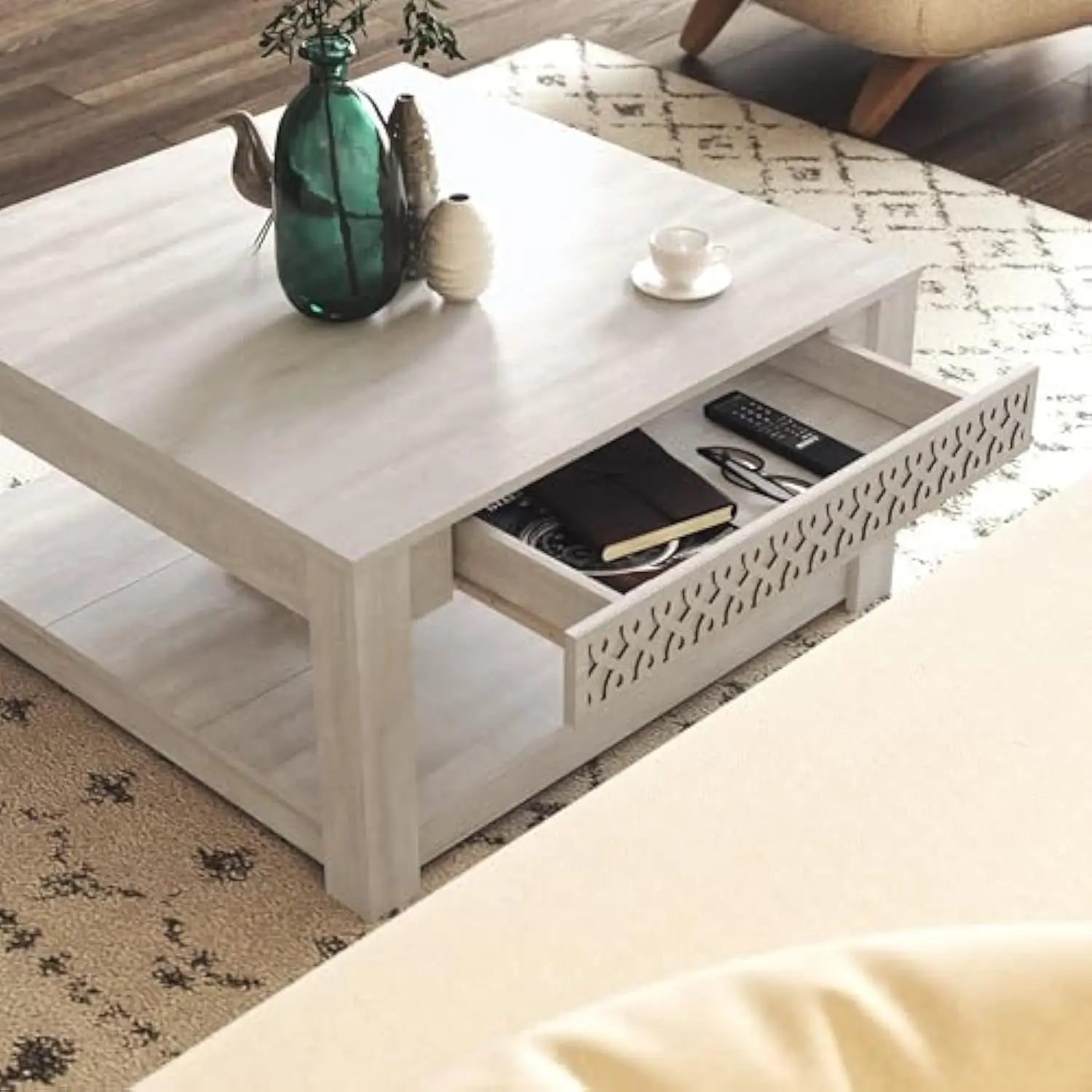
The enduring appeal of these natural materials connects directly to the sustainability values in Danish design. By creating furniture from quality materials, designed to last generations rather than years, Danish coffee tables represent an environmentally conscious approach to home furnishing. The collection of solid wood coffee tables demonstrates this commitment to quality natural materials.
Signature Elements of Danish Coffee Tables
Danish coffee tables are instantly recognizable through distinctive design elements that reflect their design philosophy. Learning to identify these signature features helps you recognize authentic Danish-inspired pieces.
Distinctive Leg Styles
The legs of Danish coffee tables often become defining design elements:
- Tapered legs that angle outward slightly (splayed legs) create visual dynamism while providing stable support
- Slender proportions that appear delicate yet provide surprising strength through careful engineering
- Rounded profiles that soften the overall appearance while eliminating sharp edges
- Strategic placement that often creates negative space, contributing to the table’s visual lightness
Edge Treatments and Surface Details
The way edges and surfaces are handled reveals much about Danish design principles:
- Gently beveled or rounded edges that feel comfortable to the touch
- Raised edges on table surfaces that subtly contain items placed on the table
- Floating tops that appear to hover above the base, creating visual lightness
- Continuous surfaces that flow uninterrupted, emphasizing the natural beauty of wood grain patterns
Common Table Forms
Danish coffee tables appear in several characteristic shapes, each with distinct advantages:
- Rectangular tables with clean proportions that provide maximum functional surface area
- Oval designs that eliminate sharp corners while maintaining generous surface area
- Round tables that facilitate conversation and flow in smaller spaces
- Organic shapes like kidney or free-form designs that create visual interest through asymmetry
Proportional Harmony
Perhaps most distinctive is the careful attention to proportion that characterizes Danish design:
- Tables typically maintain a low profile that doesn’t obstruct sightlines across a room
- Surface areas are generously sized for functionality without overwhelming the space
- The relationship between top thickness, leg dimensions, and overall height creates visual balance
These key characteristics of Danish coffee tables demonstrate how practical considerations inform aesthetic decisions. The ability to identify authentic Danish-inspired coffee tables comes from recognizing these distinctive elements working in harmony.
Visual Showcase: Danish Coffee Table Styles
Danish coffee table design encompasses a range of distinctive styles, each offering unique advantages for different spaces and preferences. This showcase highlights key variations and their defining characteristics.
Classic Mid-Century Forms
The golden age of Danish design (1940s-1960s) produced iconic coffee table forms that continue to influence contemporary design:
The Rectangular Standard: Clean-lined rectangular tables with tapered legs represent perhaps the most recognizable Danish coffee table form. Their generous proportions and uncluttered surfaces make them versatile centerpieces.
The Round Classic: Circular tables with pedestal bases or radiating legs create dynamic visual interest while facilitating conversation in intimate seating arrangements.
The Organic Shape: Free-form or kidney-shaped tables with asymmetrical outlines bring sculptural interest and playful energy to living spaces.
Contemporary Interpretations
Modern designers continue to evolve Danish design principles while honoring traditional craftsmanship:
Mixed Material Tables: Contemporary Danish-inspired designs often combine traditional woods with steel, concrete, or engineered materials for fresh interpretations of classic forms.
Modular and Transforming Designs: Adaptable tables with adjustable heights, expandable surfaces, or nested components reflect today’s flexible living spaces.
Minimalist Expressions: Some contemporary designs reduce forms to their absolute essence, creating ultra-clean silhouettes that still maintain Danish principles of craftsmanship.
Functional Variants
Danish design’s emphasis on functionality has produced specialized coffee table types:
Storage Solutions: Tables with integrated drawers, shelves, or compartments maintain clean lines while offering practical organization.
Nesting Tables: Nesting coffee tables with Danish design influences provide versatile surface options that can be reconfigured as needed.
Two-Tier Designs: Tables with additional lower shelves maintain visual lightness while doubling functional surface area.

Shape Considerations
Different shapes serve different purposes in interior design:
Rectangular Tables: Ideal for larger seating arrangements, providing ample surface for multiple users.
Round Coffee Tables in Danish Mid-Century Style: Perfect for promoting conversation and improving flow in smaller spaces or with sectional seating.
Square Tables: Create formal balance and work well in symmetrical room arrangements.
Oval Tables: Offer the surface area of rectangular designs while eliminating sharp corners, making them ideal for homes with children.
Each style maintains core Danish design principles while offering specific advantages for different spaces and lifestyles. The variety ensures that Danish-inspired coffee tables can complement virtually any interior while providing enduring functionality and beauty.
Notable Designers and Their Coffee Table Contributions
The evolution of Danish coffee table design owes much to pioneering designers who elevated functional furniture to an art form. Their innovative approaches continue to influence contemporary designers and define what we recognize as Danish style.
Pioneering Danish Designers
Hans Wegner
– Known for organic, sculptural forms that maintained functional clarity
– Emphasized exceptional joinery techniques with visible craftsmanship elements
– Created tables with distinctive three-legged designs that demonstrated remarkable stability
– Focused on creating “just right” proportions through countless refinements
Finn Juhl
– Developed more sculptural, expressive forms than many contemporaries
– Created free-form table surfaces that functioned as practical sculpture
– Combined different woods to create visual interest through material contrast
– Designed coffee tables as integral components of comprehensive room concepts
Børge Mogensen
– Emphasized straightforward, democratic design with clean rectangular forms
– Created sturdy, practical tables that prioritized function while maintaining beauty
– Focused on creating affordable quality through efficient construction methods
– Developed tables with integrated storage that never compromised design integrity
Grete Jalk
– Pioneered innovative molded plywood techniques for coffee table forms
– Created tables with exceptional lightness despite structural stability
– Designed pieces with gently curved surfaces that invited touch
– Developed production methods that made quality design more accessible
Evolution of Danish Coffee Table Design
Danish coffee table design has evolved through distinct phases while maintaining core principles:
- Early Period (1940s): Focused on solid construction and traditional craftsmanship with emerging modern forms
- Golden Age (1950s): Refined proportions and developed signature elements like tapered legs and floating tops
- Experimental Period (1960s): Incorporated new materials and more sculptural forms while maintaining functionality
- Contemporary Revival: Combines traditional methods with modern manufacturing to create accessible Danish-inspired designs

Understanding the broader context of Scandinavian design influence on furniture helps place Danish coffee tables within their regional context. While sharing certain principles, comparing Scandinavian and Danish coffee table design traditions reveals distinctive Danish characteristics like exceptional joinery details and material emphasis.
Contemporary designers continue this legacy by honoring traditional principles while incorporating modern innovations in materials and production methods. This evolution ensures Danish coffee table design remains relevant while maintaining its distinctive character and quality standards.
Finding Your Perfect Danish-Inspired Coffee Table
Selecting the ideal Danish-inspired coffee table requires thoughtful consideration of your space, needs, and aesthetic preferences. This methodical approach will help you find a piece that brings lasting satisfaction.
Assess Your Space and Functional Requirements
Before shopping, evaluate your specific needs:
- Room dimensions: Measure your available space, allowing at least 18 inches between the coffee table and seating
- Traffic flow: Consider how people move through the space to determine optimal placement
- Usage patterns: Think about how you’ll use the table (casual dining, displaying items, games, work)
- Storage needs: Determine if you need integrated storage for remotes, magazines, or other items
- Existing furniture: Consider the height and scale of your seating (table height should be within 1-2 inches of cushion height)
Choosing the Right Shape
Different shapes serve different purposes:
- Rectangular: The most versatile choice, ideal for larger seating arrangements or longer sofas
- Round: Perfect for promoting conversation and improving traffic flow in tighter spaces
- Square: Works well with symmetrical furniture arrangements or sectionals
- Oval or organic: Combines advantages of rectangular surface area while eliminating sharp corners
Material Considerations
Select materials that complement your lifestyle and existing décor:
- Teak: Offers warm tones and exceptional durability with minimal maintenance
- Walnut: Provides rich, darker colors that create a sophisticated focal point
- Oak: Creates a lighter, more casual appearance that works well in contemporary spaces
- Glass elements: Add visual lightness and practicality for food and drinks
Construction Quality Markers
Learn to identify quality craftsmanship:
- Smooth, even joints with tight seams
- Drawer components that slide easily with dovetail construction
- Balanced proportions with appropriate weight distribution
- Stable design without wobbling or racking
- Even, carefully applied finish without drips or inconsistencies
Danish coffee table inspiration for minimalist homes can help you visualize how these principles translate to specific designs. The broad selection of mid-century modern coffee tables offers various interpretations of these design principles to suit different preferences.
Vintage vs. Contemporary: Navigating Your Options
When exploring Danish coffee table options, you’ll encounter both vintage pieces and contemporary interpretations. Each category offers distinct advantages worth considering.
Vintage Danish Coffee Tables
Advantages:
– Authentic connection to the original Danish design movement
– Often feature exceptional handcraftsmanship difficult to find in modern production
– Unique character developed through decades of use and patina
– Potential investment value for well-maintained pieces by recognized designers
– Sustainability benefits of reusing existing quality furniture
Considerations:
– May require restoration or refinishing depending on condition
– Original dimensions sometimes smaller than contemporary living demands
– Can be expensive for authenticated designer pieces
– May have existing damage or repairs that affect structural integrity
– Limited availability of specific designs or styles
Contemporary Danish-Inspired Tables
Advantages:
– Generally more affordable than authentic vintage pieces
– Often sized for modern living spaces and seating arrangements
– New materials benefit from contemporary manufacturing innovations
– Fresh interpretations that adapt classic principles to modern aesthetics
– No restoration concerns or existing damage to address
Considerations:
– Quality varies significantly across price points
– Mass-produced versions may lack the character of handcrafted pieces
– Some modern interpretations prioritize appearance over traditional construction quality
– May not develop the same character and patina as traditional woods and finishes
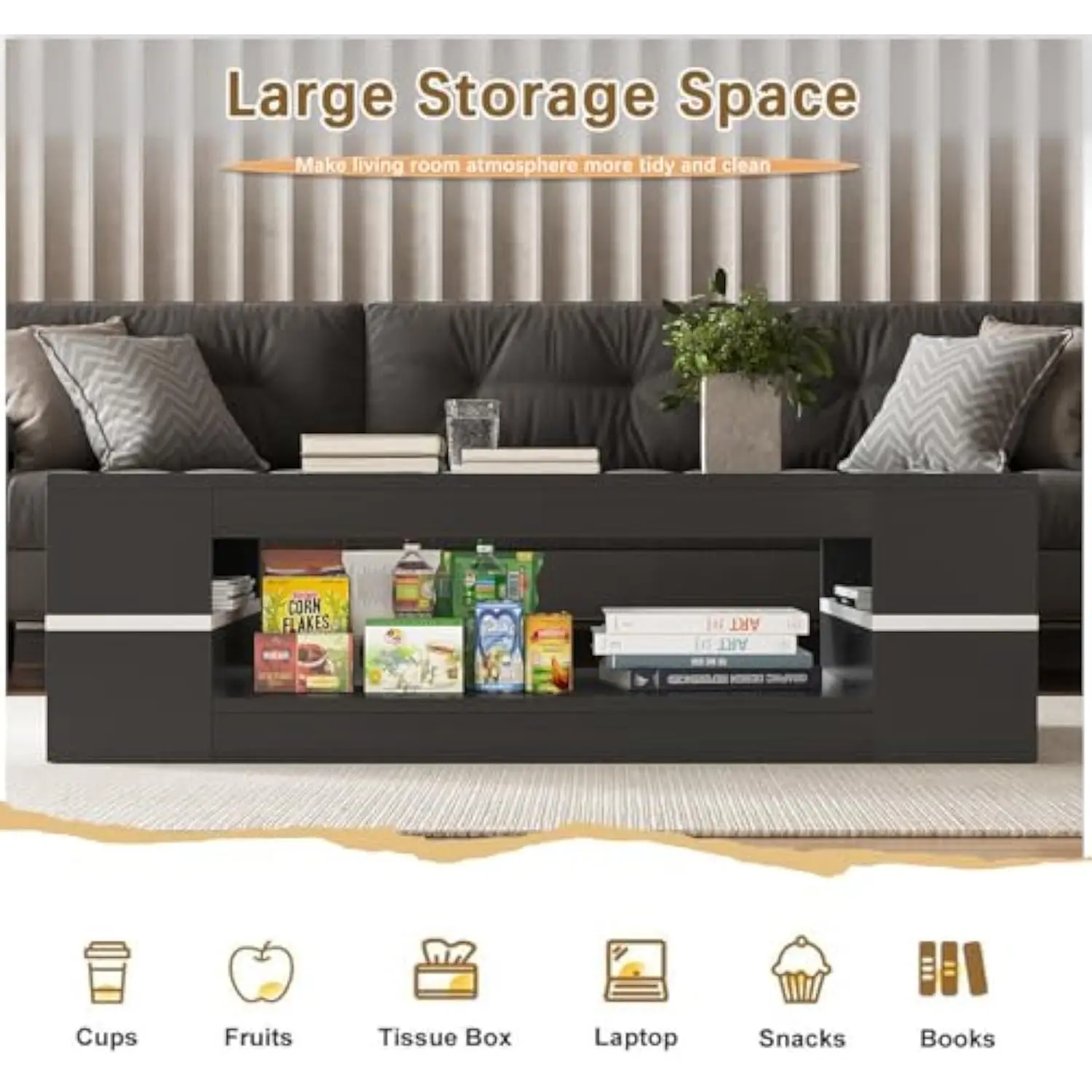
Authentication Considerations for Vintage Pieces
When exploring vintage coffee tables with Danish design elements, consider:
- Original maker’s marks or labels (often on underside or inside drawers)
- Documentation of provenance when available
- Characteristic construction techniques specific to manufacturers or designers
- Period-appropriate materials and finishing methods
- Consultation with specialists for valuable or significant pieces
For contemporary options, glass-top coffee tables with Danish influence represent a popular modern interpretation that combines traditional wood elements with practical glass surfaces.
Your choice between vintage and contemporary ultimately depends on your priorities regarding authenticity, budget, and specific functional requirements.
Identifying Quality Craftsmanship
The exceptional quality associated with Danish coffee tables stems from specific construction techniques and attention to detail. Learning to recognize these markers helps you evaluate potential purchases regardless of age or price point.
Joinery Techniques
Quality Danish coffee tables feature sophisticated joinery methods that enhance both strength and beauty:
- Mortise and tenon joints: Create strong connections between legs and structural elements
- Finger joints: Allow wood expansion and contraction while maintaining structural integrity
- Dovetail drawers: Indicate quality construction in storage components
- Spline joints: Reinforce mitered corners with contrasting wood inserts
Surface Finishing Excellence
Superior finishes enhance and protect the natural beauty of woods:
- Even, consistent application without drips, bubbles or uneven spots
- Depth that enhances grain patterns rather than obscuring them
- Smooth surfaces that feel silky to the touch without sticky residue
- Edge finishing that matches the quality of primary surfaces
Structural Integrity
Well-built Danish coffee tables demonstrate:
- Stability without rocking or wobbling
- Even weight distribution that prevents sagging or warping
- Appropriate weight that indicates solid construction without excessive heaviness
- Drawers or moving parts that operate smoothly without binding
Mid-Century Modern Solid Wood Coffee Tables, Mid-Century Modern Teak Coffee Tables
$879.95 Select options This product has multiple variants. The options may be chosen on the product pageMid-Century Modern Danish Coffee Tables, Mid-Century Modern Oval Coffee Tables, Mid-Century Modern Solid Wood Coffee Tables
$390.05 Select options This product has multiple variants. The options may be chosen on the product pageMid-Century Modern Coffee & End Table Sets, Mid-Century Modern Coffee Table Sets, Mid-Century Modern Oval Coffee Tables
Price range: $257.48 through $331.04 Select options This product has multiple variants. The options may be chosen on the product pageMid-Century Modern Glass Top Coffee Tables, Mid-Century Modern Glass Top Side & End Tables
$460.58 Select options This product has multiple variants. The options may be chosen on the product pageMid-Century Modern Glass Top Coffee Tables, Mid-Century Modern Vintage Coffee Tables, Mid-Century Modern Vintage Side & End Tables
$725.36 Select options This product has multiple variants. The options may be chosen on the product pageMid-Century Modern Lift Top Coffee Tables, Mid-Century Modern Square Coffee Tables
$454.73 Select options This product has multiple variants. The options may be chosen on the product page
The features of Danish coffee table construction and craftsmanship demonstrate how structural requirements become design elements themselves. This integration of form and function represents the essence of Danish design philosophy—creating beautiful objects where every element serves both practical and aesthetic purposes.
Caring for Your Danish Coffee Table
Proper maintenance ensures your Danish coffee table remains beautiful for generations. Different finishes require specific care approaches to maintain their distinctive appearance and protective qualities.
General Maintenance Guidelines
Regardless of finish type, follow these basic principles:
- Use coasters to prevent water rings and heat damage
- Clean regularly with a soft, slightly damp cloth to remove dust
- Avoid placing tables in direct sunlight, which can cause uneven color changes
- Maintain consistent humidity levels to prevent wood cracking or warping
- Use felt pads under decorative objects to prevent scratches
Finish-Specific Care
Oil-Finished Surfaces
– Re-oil every 6-12 months with appropriate wood oil
– Immediately wipe up spills to prevent staining
– Apply oil in thin, even coats following wood grain
– Allow complete drying between applications
Lacquered Surfaces
– Clean with mild soap and water, avoiding harsh chemicals
– Dry immediately after cleaning to prevent moisture damage
– Use high-quality furniture polish sparingly to maintain sheen
– Repair minor scratches with appropriate touch-up products
Soap-Finished Wood (Primarily Oak)
– Clean with mild soap flake solution specifically for wood
– Avoid standard household cleaning products
– Reapply soap treatment annually following manufacturer guidelines
– Accept that surface will develop patina with normal use
Addressing Common Issues
Water Rings
– For oil finishes, gentle buffing with fine steel wool and fresh oil
– For lacquered surfaces, try mayonnaise left overnight or specialized ring removers
– Persistent rings may require professional refinishing
Scratches
– Minor scratches in oil finishes can be buffed with steel wool and fresh oil
– Lacquer scratches may need specialized touch-up products
– Deep damage may require professional restoration
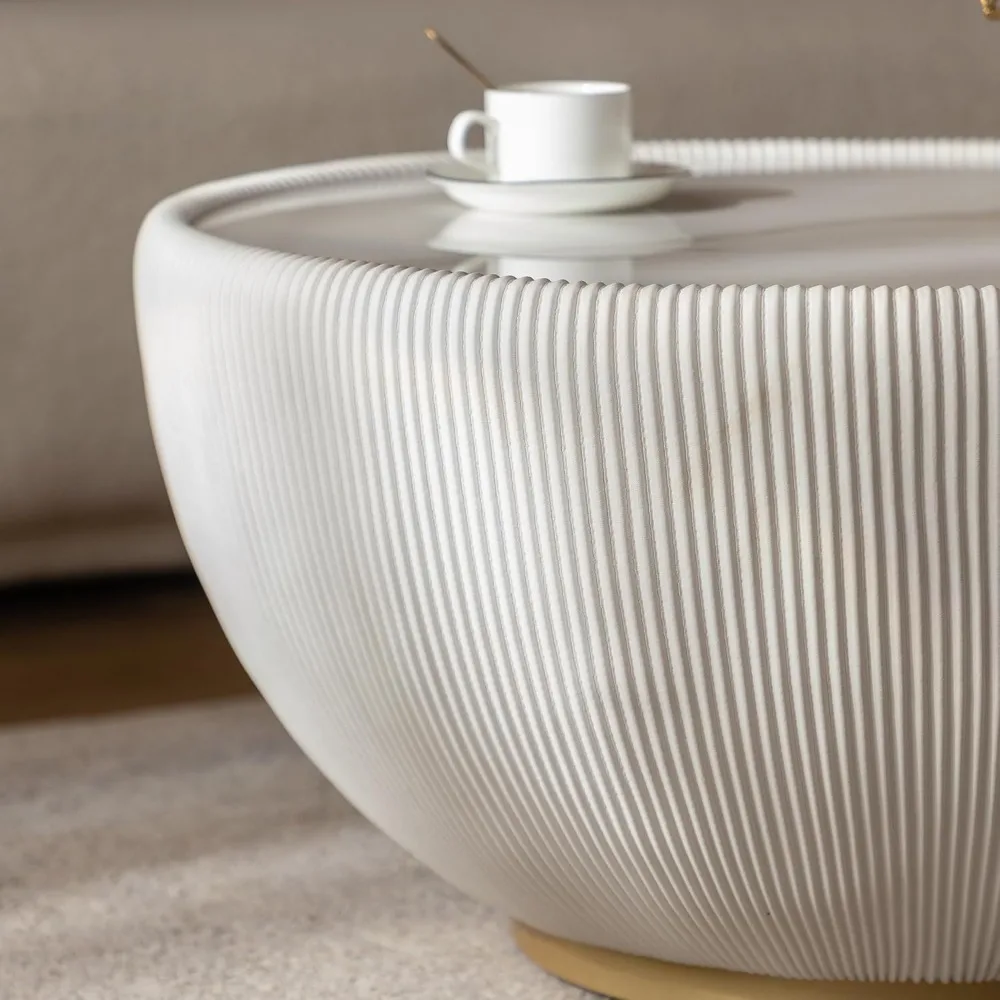
For specific maintenance needs of white coffee tables with Danish design influence, pay special attention to keeping surfaces clean without harsh abrasives that might damage finishes.
Remember that some patina development is expected and often desirable with Danish furniture. The gradual deepening of wood tones and subtle wear patterns contribute to the character that makes these pieces increasingly beautiful over time.
How to Style Your Danish Coffee Table
Styling your Danish coffee table enhances its design while creating a functional, beautiful focal point for your living space. The key lies in balancing aesthetic display with practical usefulness.
The Minimalist Approach
Danish design philosophy embraces thoughtful restraint:
- Select a few meaningful items rather than numerous small objects
- Create negative space that highlights both the table’s design and display items
- Choose pieces with intentional contrast in height, texture, and material
- Focus on quality over quantity, selecting items with both beauty and purpose
Balanced Arrangements
Create visual harmony through thoughtful organization:
- Group items in odd numbers (three or five elements often work well)
- Vary heights to create visual interest without blocking conversation
- Balance larger items with smaller complementary pieces
- Consider the view from all seating positions around the table
Material and Color Harmony
Select elements that complement Danish woods:
- Natural materials like ceramics, glass, and metals create cohesive arrangements
- Incorporate textural elements like handwoven baskets or textured ceramics
- Choose color palettes that enhance rather than compete with wood tones
- Consider seasonal touches that can be easily changed for visual refreshment
Functional Styling
Maintain the table’s practical purpose:
- Keep central areas clear for actual use (drinks, food, games)
- Incorporate practical items like candles or small dish for keys
- Consider trays to group smaller items and make clearing the table easy
- Ensure books or magazines are actually ones you’ll read or reference
Following these principles helps you create arrangements that enhance your Danish coffee table’s beauty while maintaining its functional purpose as a centerpiece for daily living and entertaining.
Can Danish Coffee Tables Work in Any Interior Style?
The versatility of Danish coffee tables allows them to complement a wide range of interior aesthetics beyond purely Scandinavian spaces. Their clean lines and honest materials make them remarkably adaptable to diverse design approaches.
Danish Tables in Contemporary Interiors
Danish pieces excel in contemporary settings:
– Their clean profiles complement today’s preference for uncluttered spaces
– Natural wood tones add warmth to modern minimalist environments
– Their functional simplicity aligns with contemporary practical needs
– Lighter Danish pieces create visual breathing room in smaller modern homes
Integrating with Traditional Décor
Danish tables can soften more formal traditional spaces:
– They provide contemporary counterpoints to heavier traditional furniture
– Their craftsmanship complements traditional quality expectations
– Natural wood tones bridge traditional color schemes with modern elements
– Their understated presence doesn’t compete with more ornate traditional pieces
Perfect Partners for Eclectic Interiors
In eclectic spaces, Danish pieces often become anchoring elements:
– Their clean design provides visual rest amid more diverse styles
– The neutral character of Danish wood complements eclectic color palettes
– Their authentic character pairs well with other genuine vintage pieces
– Their functional simplicity balances more decorative eclectic elements
Industrial and Rustic Pairings
Danish tables work surprisingly well with industrial and rustic aesthetics:
– They add warmth and refinement to industrial spaces
– Their craftsmanship complements the authenticity valued in rustic interiors
– Wood tones connect with natural elements in both styles
– Their scale typically works well with larger industrial or rustic furniture
Modern Danish coffee table designs for contemporary living rooms demonstrate this adaptability through various interpretations that maintain Danish principles while complementing today’s interiors.
The exceptional versatility of Danish coffee tables stems from their focus on fundamental design principles rather than decorative trends. By emphasizing proportion, quality materials, and functional excellence, they achieve a timeless quality that transcends specific style categories.
Modern Interpretations: How Danish Design Continues to Evolve
While respecting traditional principles, contemporary designers continue to reimagine Danish coffee table design for today’s living. These modern interpretations demonstrate how Danish design remains a living tradition rather than merely historical style.
Contemporary Material Innovations
Modern Danish-inspired designs incorporate new materials while maintaining traditional principles:
- Sustainable woods from managed forests replace increasingly rare exotic hardwoods
- Engineered wood products provide stability while conserving resources
- Metal components with new finishing techniques create distinctive contrasts
- Advanced glass manufacturing allows more complex integrated surfaces
Sustainability Focus
Contemporary Danish design emphasizes environmental responsibility:
- Water-based finishes replace traditional solvent-based products
- Modular designs allow for component replacement rather than complete replacement
- Production methods minimize waste and energy consumption
- Designs consider eventual recycling or biodegradability
Functional Adaptations for Modern Living
Today’s designs respond to changing lifestyles:
- Integrated technology accommodations (charging stations, cable management)
- Height-adjustable mechanisms for multiple uses (dining, working, relaxing)
- Smaller scales appropriate for urban living spaces
- Lightweight constructions for increasingly mobile lifestyles
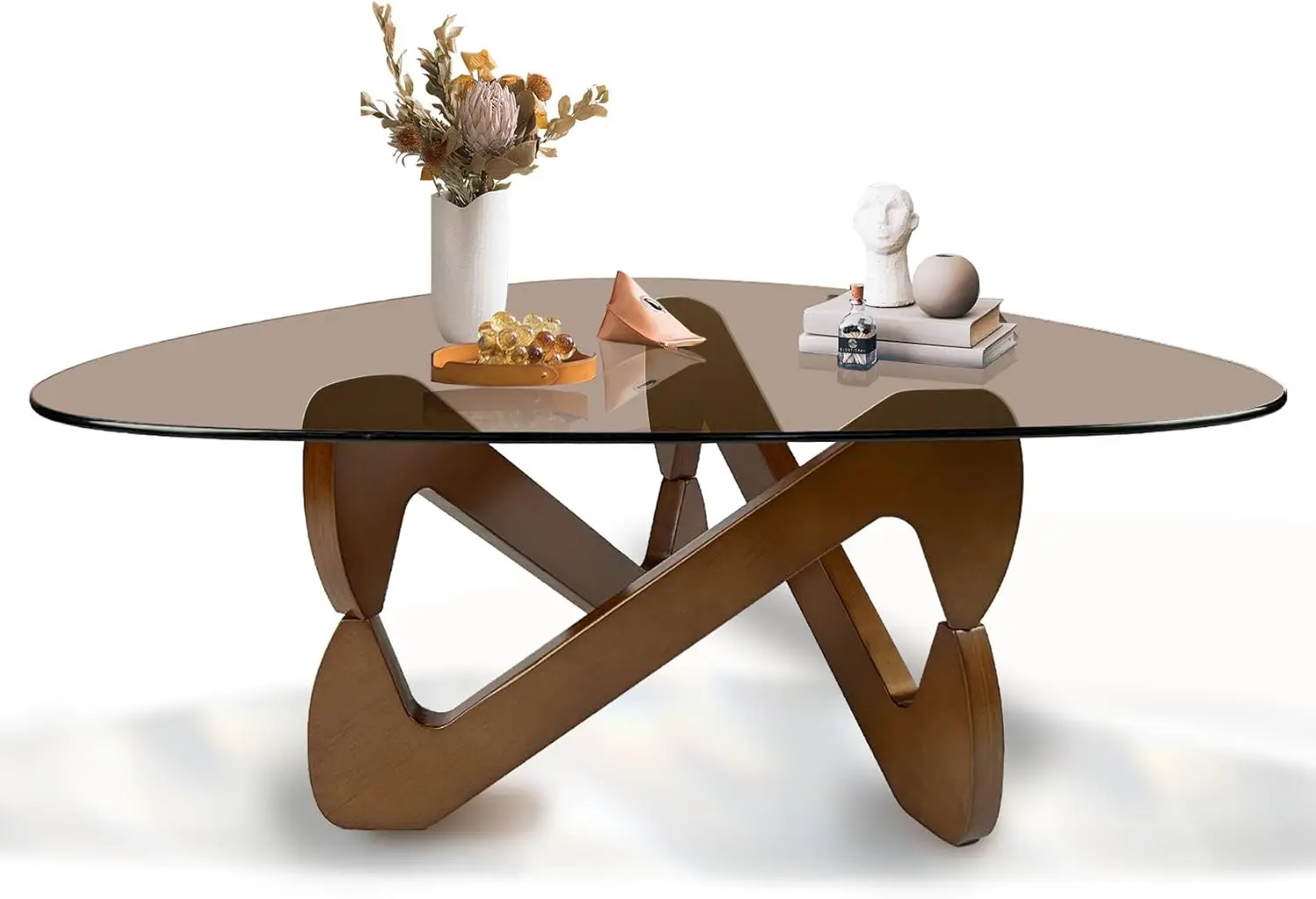
Balance of Tradition and Innovation
The most successful contemporary Danish-inspired pieces:
- Honor traditional craftsmanship while embracing modern production techniques
- Maintain material honesty while exploring new material possibilities
- Preserve functional clarity while addressing contemporary needs
- Respect historical precedent while creating fresh expressions
These evolutions ensure Danish coffee table design remains relevant rather than becoming merely nostalgic. By adapting to current needs while maintaining core principles, contemporary designers keep this tradition vibrant and meaningful for today’s homes.
Why Danish Coffee Tables Remain a Worthy Investment
Danish coffee tables represent more than just attractive furniture—they embody a philosophy of lasting quality that makes them particularly valuable investments in today’s disposable consumer culture.
Enduring Design Beyond Trends
Unlike furniture designed to follow short-lived trends, Danish coffee tables feature:
- Clean, essential forms that remain relevant across decades
- Proportional harmony that complements changing surrounding styles
- Natural materials that develop character rather than deteriorate
- Design principles focused on human needs that remain constant
Quality and Longevity Factors
The construction quality of genuine Danish-inspired pieces ensures exceptional durability:
- Solid wood construction that can last generations with proper care
- Joinery methods that accommodate natural wood movement
- Repairable designs that can be restored rather than replaced
- Finishes that can be renewed to maintain protection and beauty
Value Retention and Appreciation
Quality Danish coffee tables often maintain or increase their value:
- Authentic vintage pieces by notable designers continue to appreciate
- Well-made contemporary pieces maintain resale value unlike mass-produced alternatives
- Timeless design ensures continued desirability beyond short-term trends
- Quality materials develop desirable patina that enhances value over time
Sustainability Benefits
Investing in lasting furniture represents sustainable consumption:
- Reduces the environmental impact of frequent replacement
- Supports craftsmanship traditions that emphasize quality over quantity
- Utilizes natural, renewable materials with lower environmental footprints
- Creates heirloom pieces that can be passed down rather than discarded
This combination of aesthetic longevity, physical durability, value stability, and environmental responsibility makes Danish coffee tables particularly worthy investments in today’s world. They represent a thoughtful approach to consumption that values quality over quantity and lasting satisfaction over momentary appeal.
Are Custom Danish-Inspired Coffee Tables Worth Considering?
For those unable to find exactly what they need in existing options, custom Danish-inspired coffee tables offer a compelling alternative that tailors design principles to specific requirements.
Potential Benefits of Custom Pieces
Custom Danish-inspired coffee tables provide unique advantages:
- Precise sizing for unusual spaces or specific functional needs
- Material selection matched exactly to your existing furniture
- Design details customized to your aesthetic preferences
- Opportunity to incorporate specific functional elements
- Direct participation in the creation process
What to Look for in Craftspeople
When commissioning custom work, evaluate potential makers for:
- Demonstrated understanding of Danish design principles and construction techniques
- Portfolio showing technical skill with appropriate joinery methods
- Willingness to discuss material selection and sourcing
- Clear communication about process, timeline, and expectations
- Examples of previous Danish-inspired work showing proper proportions and details
Balancing Customization and Design Integrity
Successful custom pieces maintain Danish character while incorporating personalization:
- Preserve essential Danish principles like clean lines and functional clarity
- Focus customization on dimensions, materials, and specific functional needs
- Avoid overcomplicating designs with excessive features or ornamentation
- Respect the balance and proportions characteristic of Danish design
Investment Considerations
When evaluating custom options:
- Expect significantly higher costs than mass-produced alternatives
- Consider longer timeframes (typically 8-16 weeks) for quality custom work
- Request detailed drawings and material samples before committing
- Discuss the maker’s approach to potential issues or adjustments during the process
For those with specific needs or appreciation for direct involvement in the creation process, custom Danish-inspired coffee tables can provide exceptional satisfaction beyond standard offerings. The resulting piece becomes not just furniture but a collaborative creation that perfectly suits your space and preferences.

